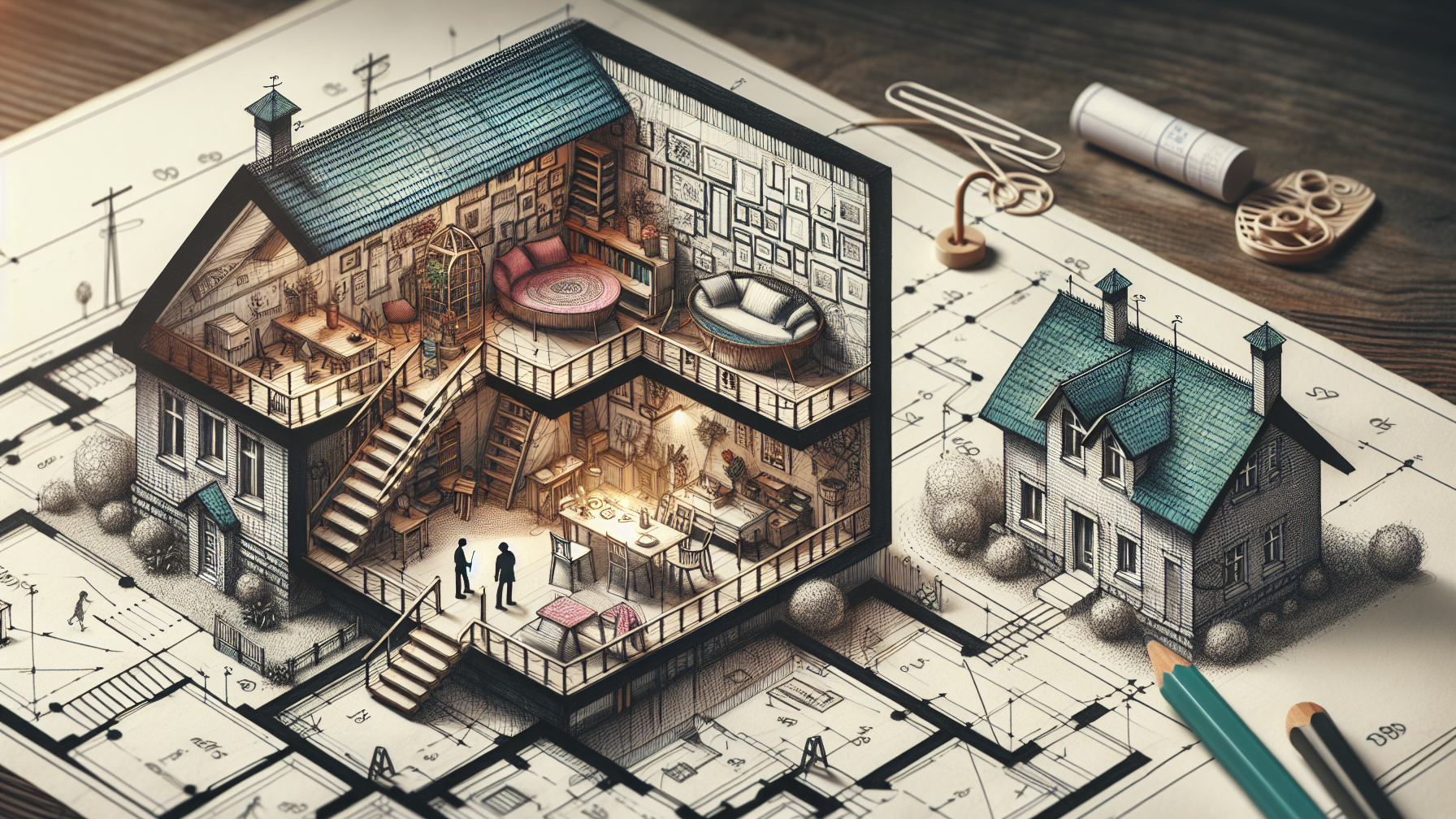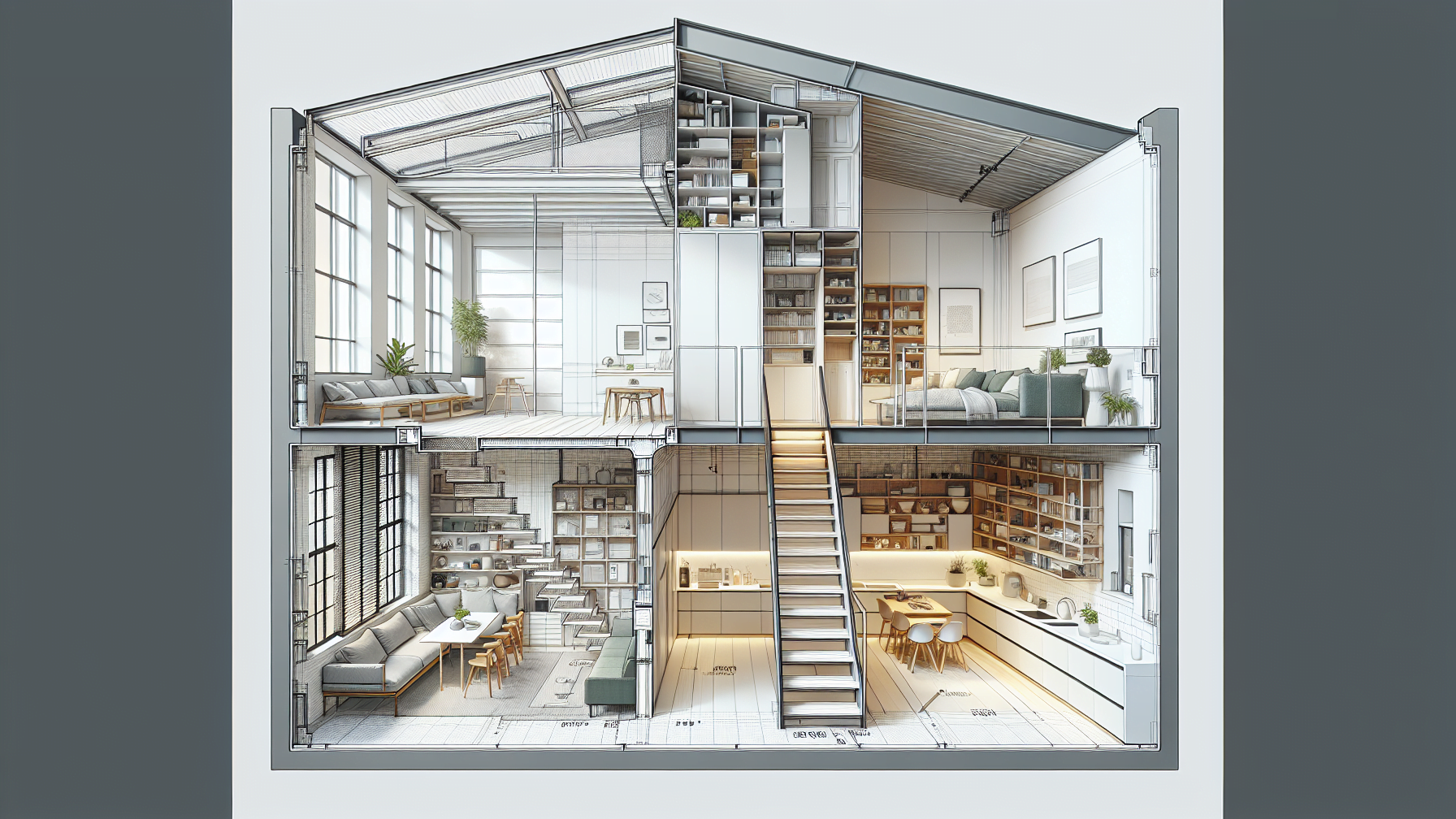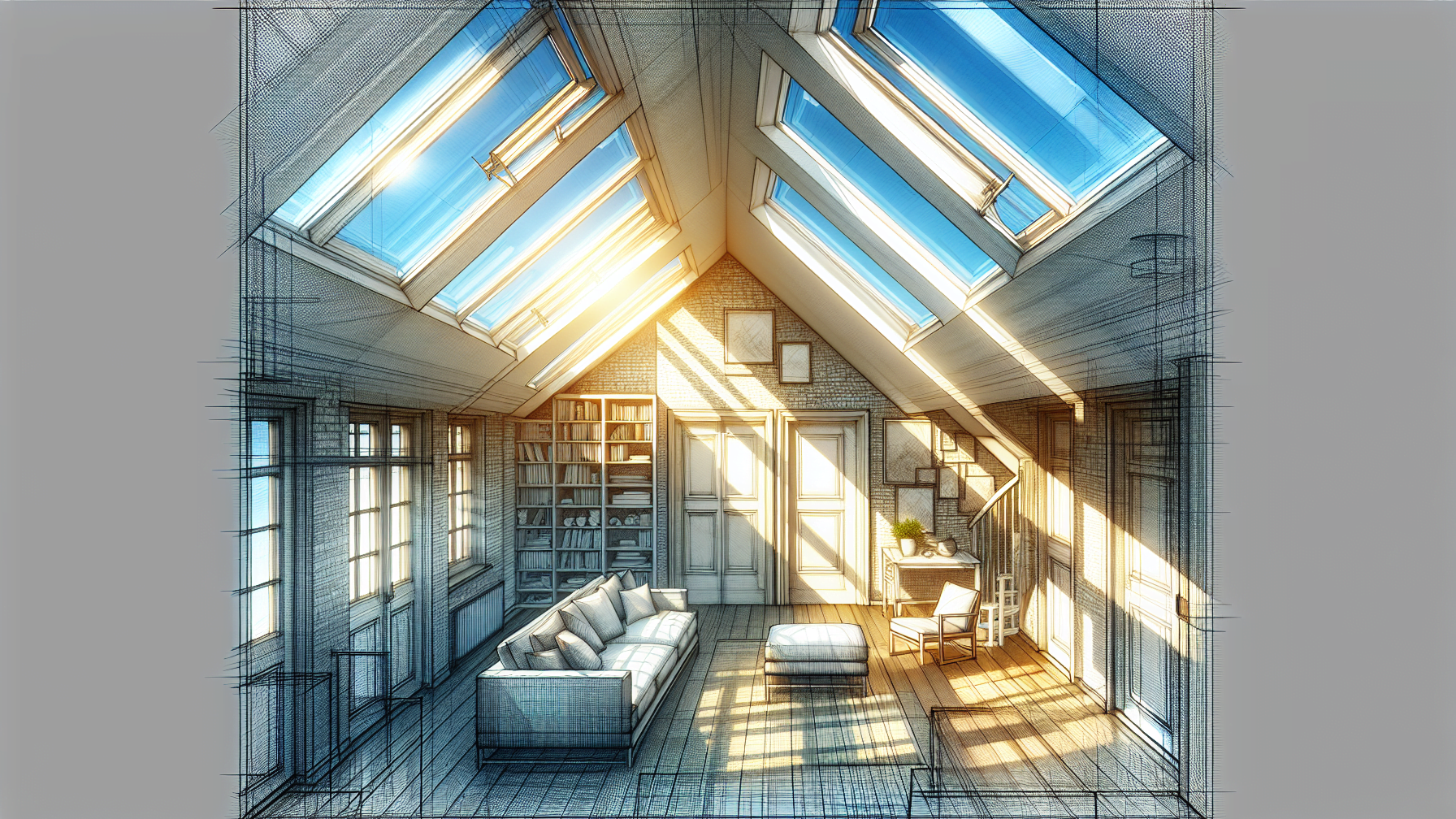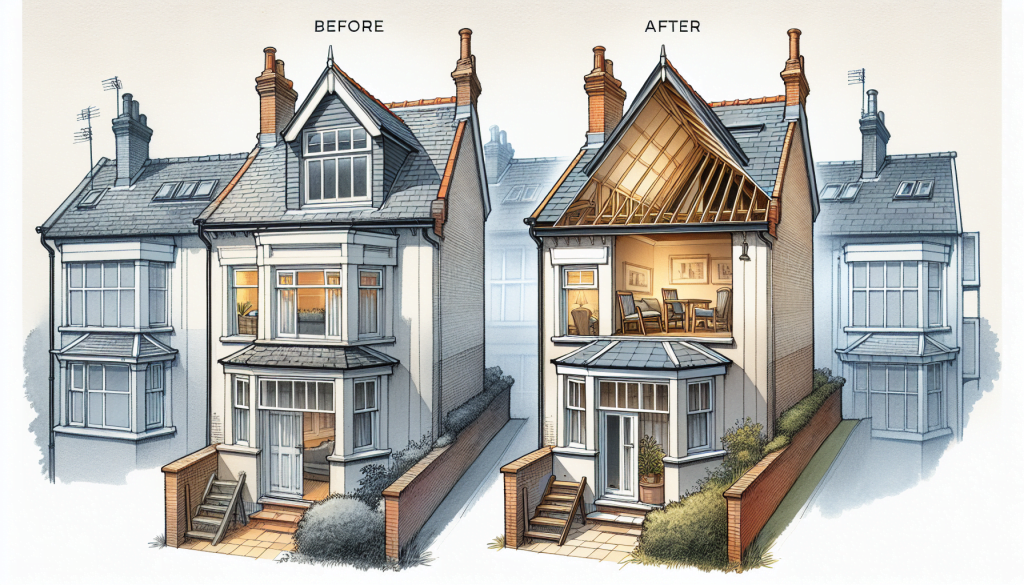Thinking about maximizing your home and looking at different types of loft conversions? The architectural solution of Hip to gable loft conversion opens up new living space by converting a roof’s sloping edge to a vertical wall, potentially boosting your property’s livable space and market value. In our comprehensive guide, you’ll learn about costs, design tips, and the legalities of the conversion, providing clarity and confidence as you consider this significant home upgrade.
Understanding Hip-to-Gable Loft Conversions
Have you ever contemplated the potential of your house’s upper angles? Transforming a hipped roof into a gable loft conversion can reveal hidden square footage. A hip-to-gable loft conversion changes the sloping side of your roof (the hip) into a vertical side (the gable) to create more space in your attic. This type of conversion adds a distinctive charm to your home’s exterior while also enlarging both floor space and vertical clearance within the attic.
With a better staircase setup, this change not only makes it easier to access your attic but also increases the ceiling height across the new space, making it feel more open and roomy. Adding features like rear dormers to these improvements can completely transform ordinary living spaces. This opens up opportunities for stunning views or luxurious guest rooms, all part of a lifestyle upgrade achieved through innovative architectural design.
The Appeal of Transforming Your Roof Space

A hip to gable loft conversion does more than simply extend the area of your home. It uplifts the quality of life by creating a greater sense of openness within. By maximizing the use of your existing structural footprint, such conversions typically increase available floor space by around 20 square meters – enhancing everyday living and potentially boosting property value between 10-20%.
There’s an added bonus: an influx of brightness in your new loft area. The strategic placement of windows or skylights can flood the newly crafted space with natural light, elevating its appeal and integrating it seamlessly as part and parcel – an attractive extension – of your residence. Whether you dream about basking in sunlight while engrossed in a book or designing masterpieces in a well-lit studio, converting your loft is key to unlocking these radiant opportunities for enrichment.
Breaking Down the Expenses: Hip to Gable Loft Conversion Cost
Taking on the project of a gable loft conversion entails significant financial planning. The expense involved in creating a gable loft can soar upwards, potentially exceeding £50,000. This outlay is shaped by various determinants, including geographical location, detailed specifications and the complexity of your chosen design. The comprehensive cost compilation covers all aspects, from construction materials to the refined details of interior decoration.
The financial scope encompasses an array of charges, such as value-added tax (VAT), payments for professional services, and the opulent touches that make the loft space distinctively yours.
Material Expenditure
The transformation of your attic begins with the selection of materials, which can fluctuate in price. Based on your project’s size, structural beams and brickwork typically cost between £1,500 and £10,000. Significant expenses are incurred through roof alterations as well. Expect to spend about £4,200 to £10,000 on structural adjustments and roofing materials.
Additional costs include plastering work along with flooring and carpentry – all depending on both the chosen material quality and the area covered by your loft conversion. Incorporating windows and stairways is essential not only for their visual appeal but also practical use within the space – these elements will influence your total financial plan too. Don’t neglect scaffolding and insulation: these are crucial for ensuring a secure construction process that yields an energy-efficient result in crafting this new living area under the roof.
Labour Investment
The skill required for a loft conversion doesn’t come cheap, with the involved labour being a clear indicator of that. Expect to budget an amount between £20,000 and £50,000 for the cumulative expertise of various professionals, including builders, tilers, plumbers, electricians, plasterers, and decorators. The worth each professional brings is mirrored in their hourly charges, which are indicative of both the intricacies and indispensability associated with their roles.
Hourly rates can fluctuate based on your locale or specific needs related to your loft conversion project. Securing bids from several tradespeople will allow you to scrutinize not only their pricing but also the breadth of services they offer before committing.
Hiring a skilled team is just as important as choosing high-quality materials for these types of projects. It’s about balancing cost and quality to ensure that every hour spent on improving your home helps create a great hip to gable loft conversion that meets your expectations and lasts a long time.
Planning Permissions and Regulations
Embarking on a gable loft conversion without proper legal consideration is akin to navigating unknown seas without guidance. Fortunately, the journey of hip to gable conversions often remains within the calm realm of permitted development, thereby obviating the need for conventional planning permission. This essentially means that provided your property does not exceed the existing roof’s pinnacle or sprawl past the front-facing boundary – the principal elevation – you’re typically free to advance with minimal fuss.
It’s imperative to secure your investment by obtaining a Lawful Development Certificate – this document serves as an official testament affirming that your project aligns with local zoning regulations. From architectural plans required for building control approval to necessary agreements like party wall arrangements, each piece plays a crucial role in ensuring that your loft transformation complies with regulatory standards and runs smoothly.
Bear in mind though, if you reside within a designated conservation area or aim to integrate features such as balconies into your design ambitions, then be prepared for potential complexity. Under these circumstances, additional permissions might have to be sought out.
Designing Your New Loft Space

Crafting the interior of your new loft space is comparable to bringing a fresh painting to life. From preliminary drawings to adding that last decorative touch, it’s an opportunity for your creativity and imagination to shape reality. Identifying how you intend to use the loft – whether as a peaceful bedroom sanctuary, an energetic hub for entertaining guests, or an efficient home office – is crucial in setting the direction for this inventive process.
In creating your new loft, every decision regarding its design should harmoniously integrate with both the current architecture and optimize functionality while reflecting personal taste. This includes everything from strategically placing staircases for accessibility, choosing dormer windows that enhance light and space – all tailored specifically around enhancing everyday living according to your unique preferences.
Floor Plan Optimization

Mastering the use of both horizontal and vertical dimensions is crucial in optimizing a hip-to-gable loft conversion, transforming it into an area that’s not only aesthetically appealing but also highly functional for everyday use. To enhance space within your new loft effectively, consider these tactics:
- Integrate built-in storage to efficiently utilize eaves and unconventional angles
- Opt for furniture with multiple functions, which aids in saving valuable space
- Employ smart design features like concealed compartments or beds that can be folded away to maximize floor space without sacrificing either style or comfort
In applying these approaches, one can fashion a dormer loft conversion that marries practicality with visual charm.
Cultivate an atmosphere of spaciousness by adopting open-plan layouts along with colour schemes that augment natural light exposure. The careful consideration given at this phase will result in a well-executed hip to gable loft conversion – offering a sense of expansiveness while maintaining cosiness – an expertly organized yet exquisitely designed sanctuary.
Incorporating Natural Light

Proper lighting has the power to elevate a loft from an ordinary space to one of tranquillity and peace. Architectural design that focuses on harnessing natural light is crucial for creating a living area that’s both livable and soothing. To infuse your loft with natural light, you can consider various methods such as:
- Fitting skylights which allow sunlight to cascade into the room, bringing it vibrantly alive
- Incorporating expansive windows or walls made predominantly of glass in order to optimize exposure to daylight
- Implementing light wells or shafts designed to draw illumination down from higher levels or directly from the roof into your loft
By implementing these strategies for incorporating staircases in lofts, you’ll cultivate a luminous and welcoming environment within your attic retreat.
Dormer windows not only act as conduits for increased brightness but also enhance both the visual appeal and usability of your loft by raising ceiling height and providing scenic views that establish a link with nature outside. When selecting locations for window installation, think about the sun’s trajectory throughout the day to amplify its presence in the loft space.
In places where regular windows don’t work, solar tubes are a creative way to bring sunlight directly into dark areas of lofts, making sure even the hidden corners get sunlight.
The Step-by-Step Construction Process
Once the plans are set and permissions are in place, starting a gable loft conversion is like a well-organized performance. It takes about 6 to 8 weeks and 2-3 skilled workers to change a sloped (hip) roof into a straight (gable) roof. They begin by setting up scaffolding, bringing in the needed materials on time, and carefully cutting into your roof to create your new living space.
The Initial Phase: Roof Alterations
The initial construction stages for creating a hip and gable roof during the transformation of a hip to gable conversion involve:
- Lengthening the central ridge of your existing hip roof, which elevates and expands the potential living space upwards.
- Converting one sloping side (the hipped part) into an upright vertical wall that stretches up to converge with this extended ridge line.
- Developing the new expanded area that characterizes what’s involved in a successful hip to gable conversion.
This process is focused not only on expansion but also on achieving aesthetic cohesion between the established structure and the new addition. The creation of a seamlessly integrated vertical gable end wall exemplifies both craftsmanship excellence and architectural precision crucial for preserving your home’s overall design integrity while enhancing it through this change from hip roof to gable roofing system.
Creating the Structure: Building the Extension
The transformation of the gable roof unfolds as we venture into crafting the gable extension. This phase is crucial, focusing on fortifying the current flooring to support your vision’s load. The key element in this expansion is the gable end, which seamlessly joins with a freshly erected vertical wall, extending from your home’s original roof slope.
This stage encompasses installing insulation and constructing interior elements along with strategically designing stairways within this new domain. It involves an elaborate process where each component – every nail, beam, and tile – is essential for guaranteeing that your newly created living space stands durable and fully functional.
Adding Value and Functionality with a Hip to Gable Loft
Transforming your existing roof with a hip to gable loft conversion is not merely an aesthetic change, but a significant enhancement that brings both practicality and added value to your property. By converting the available space under your roof into a functional gable loft, you open up opportunities for various uses like accommodating an extra guest room, establishing an opulent master suite or designing a customized home office. Such an upgrade introduces fresh dynamics in terms of layout and attractiveness within your residence.
Envisioning a Master Bedroom with En Suite
Imagine settling down each night in a serene master bedroom located at the very top of your home, equipped with an opulent en suite for added luxury. By incorporating both a gable end and a flat roof rear dormer into your loft conversion, you can significantly expand the loft area to create an airy retreat that greatly increases your upright living space.
Crafting this new loft into a lavish master bedroom complete with its own en suite is not just an upgrade in comfort and elegance for yourself. It’s also an alluring feature that could intrigue prospective buyers if ever there comes a time to sell. This investment adds immediate value by elevating daily experiences while promising future appeal.
Crafting the Perfect Home Office
In the modern era, combining personal living areas with professional workspaces has become increasingly important. Transforming unused attic space through a hip to gable loft conversion provides an essential additional room that can serve as an ideal home office, where concentration and creativity go hand in hand.
By utilizing this new section of your home, which is flooded with natural light and set apart from everyday household disturbances, you create a sanctuary conducive to intellectual exploration and efficient work practices. This inviting gable loft area encourages bold aspirations and diligent effort in the serenity of your own dwelling.
Energy Efficiency and Insulation Considerations
Prioritizing energy efficiency is crucial when transforming your loft with a hip to gable conversion. Effective insulation goes beyond simply adhering to building regulations. It also creates a cosy, financially beneficial, and environmentally friendly environment. By maintaining an even temperature in your converted loft all year round, you ensure it stays warm during the colder months and cool throughout summer.
Adopting top-tier insulation solutions for your gable loft can turn it into a paragon of eco-friendliness. Although costs may vary between £10 and £50 per square meter for these insulating materials, making an investment in features that conserve energy is astute financial planning that yields ongoing savings on heating and cooling expenses while enhancing comfort levels within the space.
Selecting the Right Contractor for Your Project
Choosing a contractor with proven expertise is crucial for the success of your loft conversion. It’s essential to determine if they have sought-after credentials or membership in reputable professional organizations, which signals their dedication to high-quality workmanship. Assessing and authenticating testimonials can shed light on their dependability as well as previous clients’ contentment.
The significance of having proper warranties and insurance coverage should not be minimized. This ensures that your financial commitment is safeguarded, giving you confidence that those working in your home will handle it with great care.
It’s equally important to meet and familiarize yourself with the contractor’s team members because these are the people who will become a part of your household during the renovation period.
Hip to Gable Loft Conversion Experts: Amber Lofts
Transforming your loft space into the room you envision necessitates collaboration with professionals adept in this niche. Amber Lofts stands out as a pillar of specialization, boasting more than twenty years of dedication to mastering luxury loft conversions, enlargements of living spaces, and rejuvenation projects.
Our services extend across various southern regions beyond the Thames River, including areas such as Weybridge, Hersham, Oxted, and Cobham. Over time, we have fortified our standing by consistently offering full-range solutions characterized by superior craftsmanship and excellent value for investment.
To summarise
From the initial sketches to the final stroke of paint, a hip to gable loft conversion is a journey that reshapes your home and your lifestyle. It’s about creating spaces that spark joy, add tangible value, and offer a sanctuary within your existing walls. With careful planning, the right team, and a touch of creativity, the sky’s the limit for your new loft space. May this guide serve as your compass, leading you towards an elevated home experience that is both luxurious and practical.
Key Takeaways
- Hip-to-gable loft conversions maximizes underutilized attic space by transforming sloping hipped roofs into vertical gable walls, thereby increasing floor space and headroom.
- Financial considerations for a hip-to-gable conversion include material and labour costs exceeding £90,000. These projects can add significant value to a home, potentially increasing its worth by 10-20%.
- Efficient planning, adherence to building regulations, and ensuring proper insulation are paramount for a successful loft conversion, which includes considering natural light, smart design, and energy efficiency.
What are the benefits of the hip-to-gable loft conversion?
A hip-to-gable loft conversion significantly enhances your home by transforming a sloping roof into a partially horizontal surface, thereby generating an abundance of space and substantial headroom. This type of gable loft alteration not only maximizes the area within the loft but also substantially increases your property’s value.
Do I need planning permission for a hip-to-gable loft conversion?
Undertaking a hip-to-gable loft conversion is considered permitted development and does not necessitate planning permission. However, to ensure the work is legally compliant, it is advisable to secure a Lawful Development Certificate.
How long does a typical hip-to-gable conversion take to complete?
The process of transforming a hip roof into a gable one—a procedure known as hip-to-gable conversion – can be expected to take 6 to 8 weeks. This duration may adjust in response to the particular complexities inherent in each individual project.
Can a hip-to-gable conversion increase the value of my home?
Yes, a properly done hip to gable loft conversion can increase your home’s value significantly by adding functional space and aesthetic appeal.
What are some design considerations for optimizing space in my new loft?
When optimizing space in your new loft, prioritize assessing both horizontal and vertical dimensions, use built-in storage solutions, consider an open-plan design, and enhance natural light through strategic window and skylight placements for a sense of spaciousness.
